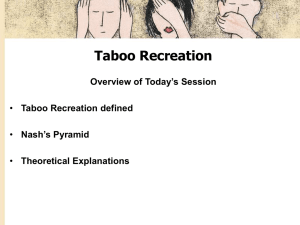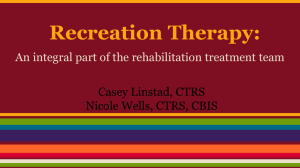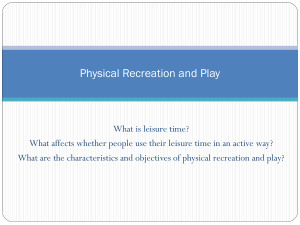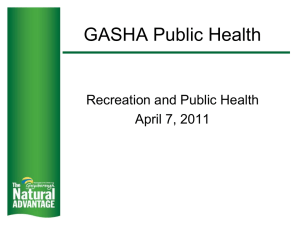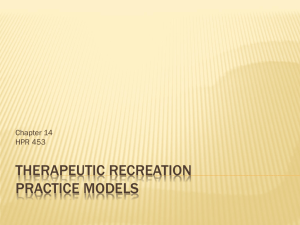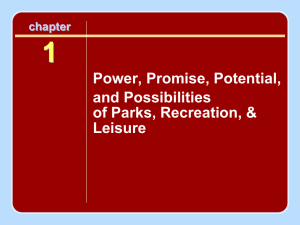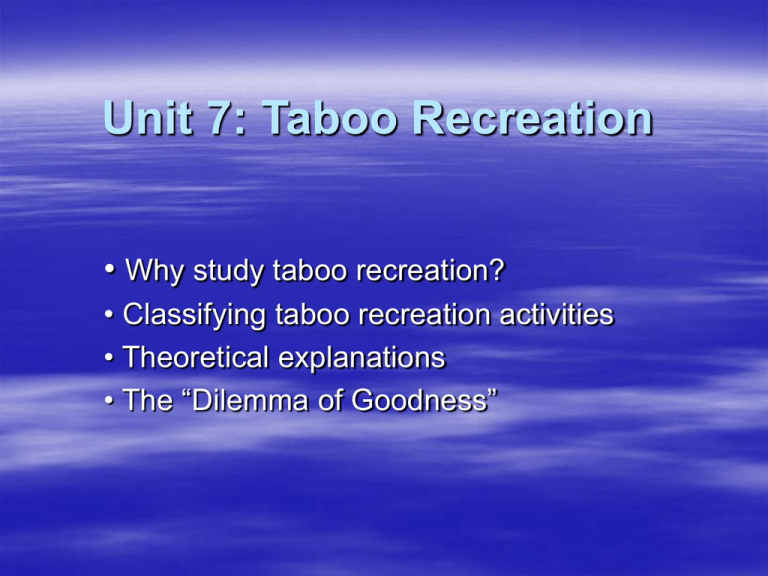
Unit 7: Taboo Recreation
• Why study taboo recreation?
• Classifying taboo recreation activities
• Theoretical explanations
• The “Dilemma of Goodness”
If leisure can enhance someone’s
life, can it also destroy life?
Close to 100% of high school students have tried
alcohol.
1,811,000 arrests for DUI yearly.
Unauthorized gambling represents about 28% of
total gambling market….21,000 arrests.
111,400 people arrested annually for prostitution.
326,000 people arrested annually for vandalism.
Taboo Recreation
Taboo recreation can be defined as those
pastimes that are forbidden by law, custom
or belief
– Each society has values, norms, and morals
that define what is considered deviant
Deviance can be defined as any behavior
that is different from what is socially
accepted in any given society
Social Taboos
Taboos differ in societies and also
change over time
Can you think of any social taboos that
some don’t think are right?
– Salary
– Clothing
– Dancing
– Religion
Purple Recreation
Defined as “those activities and interests indulged
in by youth and adults during non-work, non-study
free time that do not fall within the parameters of
what society generally views as wholesome or
good” (Curtis, 1988)
The color purple represents the shaded area of
moonlight that is neither white light nor black
shadow. It is the half area between.
The Curtis Scale
Extreme
Extreme
Positive
Negative
“BAD”
Pre-meditated murder,
Torture, brutality to
aged or disabled,
incest, sodomy
Neutral
“GOOD”
Generosity, pure love
brotherhood, total
selflessness
The Nash Pyramid
Taboo Recreation
Labels from the Nash Pyramid
Injuring Self: the harm from the activity is mainly to
those who participate.
– Substance Abuse
– Compulsive overuse
Can “good” behaviors or activities be “bad” if they become
compulsive?
What type of leisure behaviors or activities can you identify as
compulsive?
– Gambling?
– Lotteries?
– Bingo?
Taboo Recreation
Labels from the Nash Pyramid
Injuring Others: antisocial acts or crimes with
victims… behaviors that injure others.
– Vandalism for fun
– Taboo sex
– Vandalism types:
Malicious vandalism • Self-expression vandalism
Thrill vandalism
• Spin-off vandalism
The Golden Mean & Moderation
Aristotle taught us that good actions could
be defined by exercising the “golden mean”
The “golden mean” is the point of
moderation between any two extremes
Examples: drinking alcohol & eating
A life of good action, lived according to the
golden mean, will bring the greatest
happiness
Why do people engage in
unacceptable behaviors?
– Leisure participation goes up, boredom
goes down
– Leisure satisfaction goes up, boredom
goes down
– Social, sport participation, outdoor recreation
and reading work best to reduce boredom
– Many purple recreation experiences also
provide thrills and challenges
Leisure’s Potential for Anomie
Anomie: a lack of purpose and identity in a
person or a society resulting in the demise of
formerly useful social norms
– Examples:
Sports Spectating
Adolescent behavior
Leisure’s Potential for
Differential Association
Differential Association: delinquent
behavior is learned through interaction
with others in intimate personal groups.
– Example:
Youth gangs
Retreatist Lifestyles
Retreatist Lifestyle --choosing to live in a
way that differs from dominant social norms
as a matter of personal expression.
– Examples:
Communes
Drugs & sexual experimentation
The Dilemma of Goodness
Is leisure only leisure when it is good or
moral? What about recreation?
The hedonistic error
Dustin’s standard of goodness:
“Recreation rightly understood is a
matter of virtuous conduct”
Standards of Goodness
“Things are good when they contribute to our
physical and mental health, our sense of being loved
and loving, our feelings of belonging and self-esteem
and ultimately our personal growth and
development. Things that work against the fulfillment
of these needs are bad for us no matter how
pleasurable they might be.” Dustin, 1986
Standards of Goodness
“A thing is right when it intends to
preserve the integrity, stability, and
beauty of the … community of life. It is
wrong when it tends otherwise.” Aldo
Leopold
Implications of Recreation as
Virtuous Conduct
We can educate ourselves and others
We must remember that in order for an act
to be virtuous, a person must choose for
themselves
Recreation providers should be conscious
about ethical behaviors and educate clients
accordingly
Final Thoughts
How could knowing about the relationship
between leisure and deviance make a difference?
How can the theories and research presented
here equip you to live a more satisfying life?
Could this information make you a better citizen?
What would you teach your children to prepare
them for difficult choices they may face?
What do you wish you had known, or understood,
earlier in life about taboo recreation?

